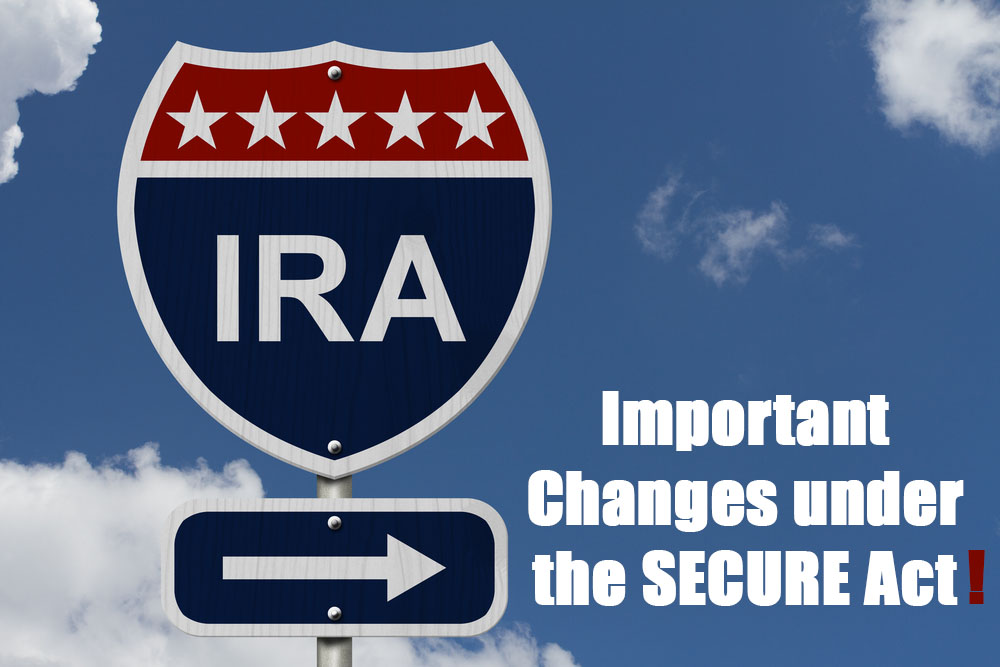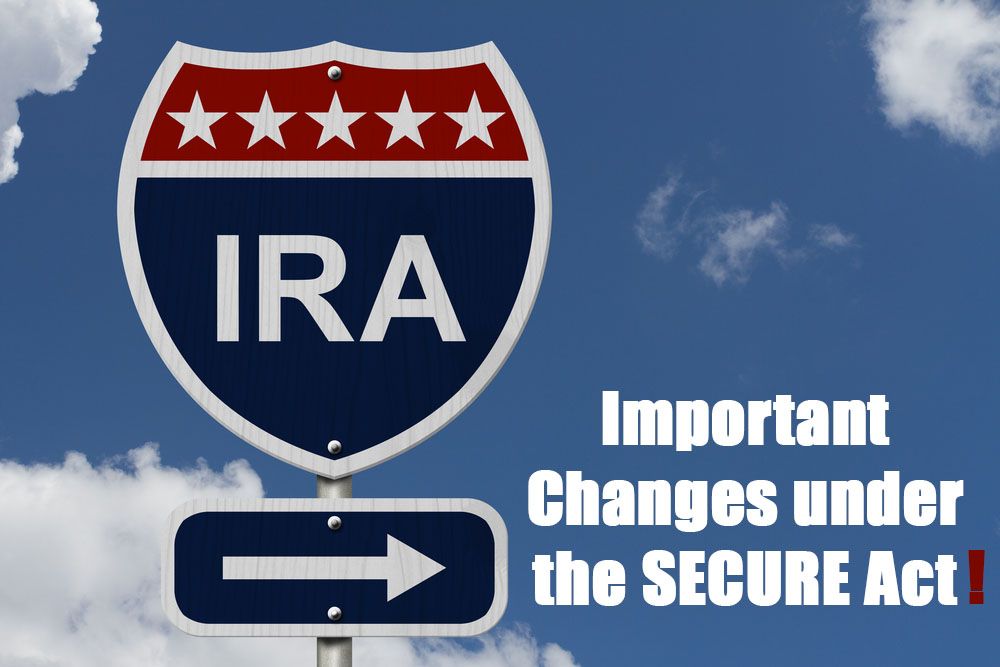Important IRA and Roth Changes Under the SECURE Act

by: P. Lewis Robinson, CPA | Managing Director, Senior Wealth Advisor CapSouth Wealth Management, McDonough, GA Office 1.8.2020
Congress has passed the year-end Spending Package that includes the SECURE Act that became effective January 1, 2020. President Trump signed the bill on Friday, December 20, 2019. With the passing of this bill there are major changes to the rules for IRAs and Roth IRAs. Although there were also changes in the 401(k) world, this article will focus only on the changes to IRAs and Roth IRAs.
The following is a summary of the major changes to IRAs and Roth IRAs:
- Due to people working longer, Congress has pushed out when required minimum distributions (RMDs) begin. For anyone who has not reached age 70.5 by the end of 2019, the new required beginning date will be 72 for RMDs. There is an exception to this rule if you are not a 5% owner in the company and continue to work; in this case you can push out your RMDs for your current employer’s retirement plan until the year after you retire.
- We have many clients who take advantage of Qualified Charitable Distributions from their IRAs at age 70 ½. This rule allows a taxpayer who is age 70 ½ years to make a distribution to a qualified charitable organization that will not be subject to income taxes. There has not been any change in this provision. At age 70 ½, a taxpayer can still make Qualified Charitable Donations. If you have a question as to how this could reduce your income taxes, call you financial advisor at CapSouth Wealth Management.
- Under the old rules, there was an age limitation to being able to make deductible Traditional IRA contributions. Under the new bill, there is no age limit for making IRA contributions as long as you or your spouse have earned income. If you are a participant in a company retirement plan, you may not be able to make an IRA contribution or may be subject to contribution limits. Discuss these limitations with your tax advisor.
- One of the more appealing Roth IRA rules is the lack of an age limit on contributions. While traditional IRA contributions were barred for individuals older than 70 ½ before January 1, 2020, you could and still can be any age and contribute to a Roth IRA if you or your spouse has earned income. However, there are limitations that you should be aware of. Discuss these limitations with your tax advisor.
- The new law allows taxable non-tuition fellowship and stipend payments to be treated as compensation to qualify for an IRA (or Roth IRA) contribution.
- What has been called the Stretch IRA has been limited. Under the old law, beneficiaries, other than a spouse, could take Inherited IRA distributions over their lifetime. Now, Inherited IRAs and Roth IRAs will have to be distributed to the beneficiaries, other than an eligible designated beneficiary (EDB), within 10 years beginning the year of the death of the account holder. In addition to the surviving spouse, there are four other categories of EDBs that are discussed in the next point.
- The following is a list of the eligible designated beneficiaries (EDB) that are entitled to a modified version of the life expectancy payout method:
- Minor child (but not grandchild) of the participant. The life expectancy payout applies to a “Child of the employee who has not reached majority.” Upon reaching the age of majority, the ten-year rule becomes effective.
- A child may be treated as not reaching the age of majority if the child has not completed a specified course of education and is under the age of 26.
- A child who is disabled within the meaning of the IRS regulations when the child reaches the age of majority may be treated as having not reached the age of majority so long as the child continues to be disabled.
- Disabled beneficiary. The life expectancy payout applies to a designated beneficiary who is disabled within the meaning of the IRS regulations. Upon their death, the 10-year payout rules become effective.
- Chronically ill individual. The life expectancy payout applies to a designated beneficiary who is chronically ill within meaning of the IRS regulations. Upon their death, the 10-year payout rules become effective.
- Less than 10 years younger beneficiary. The life expectancy payout applies to an individual who is not 10 years younger than the participant. Upon their death, the 10-year payout rules become effective.
- There will be tax planning opportunities for those who inherit IRAs. Unlike with the old rule, there is no required amount to be paid out each year of the 10 year pay out period. The beneficiaries could take larger distributions in years where the beneficiaries’ tax bracket is low or lesser amounts when their tax bracket is high.
- The effect of limiting the stretch of the IRAs and Roth IRAs is as follows:
- The income taxes payable by the beneficiaries would probably be higher since they can not spread the income taxes over a longer period.
- The deferral of the income taxes would be much shorter.
- Shorter period of tax-free growth of Roth IRAs.
- In my opinion, the change in the stretch IRA or Roth IRA makes life insurance a more tax efficient way to leave a legacy to your heirs.
- Every person who has named a trust as their IRA beneficiary will need to review those plans and likely look for alternative planning solutions.
- The new Act would likely cause problems for so-called “conduit” trusts. Conduit trusts have been used by IRA owners to ensure that the bulk of the inherited IRA is preserved for the beneficiary over the long haul. Any required minimum distributions (RMDs) that are distributed from the IRA to the conduit trust are then passed by the trust to the beneficiary and taxed in the year of distribution. The beneficiary may or may not have the ability to withdraw amounts in addition to the RMD.
- Under the new Act, the entire account would be distributed to the beneficiary. Going forward, IRA owners should consider using accumulation trusts instead. Accumulation trusts permit distributions from an IRA, including RMDs, to be preserved for the beneficiary inside the trust. So, although the new Act would require the entire IRA to be distributed to the trust within ten years, the assets could be held in trust for the beneficiary for as long as the terms of the trust dictate. However, an accumulation of trust would not prevent income tax from being assessed as distributions are made from the IRA to the trust.
- A major planning objective for the beneficiaries of trusts is to minimize the annual taxable income. The maximum Federal income tax rate of 37% applies to taxable income of the trust in excess of $12,951. The 37% bracket does not start for a couple until their taxable income is in excess of $622,050.
- Spouses still have the option to roll an Inherited IRA from their spouse into their own IRA or Roth IRA. They could treat the IRA or Roth IRA as an Inherited IRA or Roth IRA. In some cases, it could be an advantage for the spouse to elect to treat the IRA or Roth IRA as an Inherited IRA or Roth IRA.
- There is a new exception for the 10% penalty for distributions up to $5,000 for birth or adoption made before a taxpayer is age 59 ½ years of age. The distribution is subject to income taxes. The birth or adoption distribution amount can be repaid at any future time (re-contributed back to any retirement account).
- For parents and others with 529 education savings accounts, the legislation allows tax-free withdrawals from IRAs of as much as $10,000 for repayments of some student loans. The distributions for loan repayment amounts would be subject to income taxes.
The bottom line is that if you have retirement accounts, you should strongly consider working with a financial advisor who knows the new rules. CapSouth Wealth Management has been very pro-active with planning regarding IRAs and Roth IRAs. With this new law, there are even more planning opportunities.
CapSouth Partners, Inc., dba CapSouth Wealth Management, is an independent registered Investment Advisory firm. The information in this article has been provided by sources deemed to be reliable. However, CapSouth Wealth Management does not guarantee the accuracy or completeness of the information. This material has been prepared by P. Lewis Robinson, CPA for planning purposes only and is not intended as specific tax or legal advice. Tax and legal laws are often complex and frequently change. Please consult your tax or legal advisor to discuss your specific situation before making any decisions that may have tax or legal consequences.




